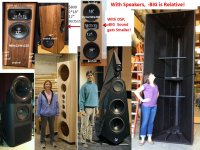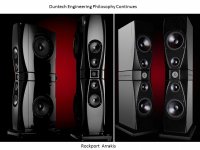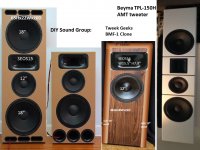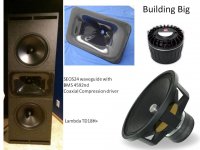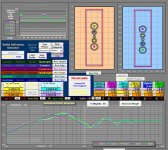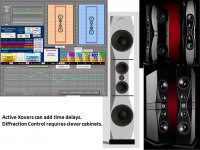Hi all.
Well, where do I start. Once upon a time I was fortunate enough to own a pair of Duntech Sovereigns. Then I got divorced. Then I didn't own a pair of Duntech Sovereigns. Now after many years of listening to a tiny pair of ProAudio I really want my lounge room full of music again. I realise the Sovereigns time has come and gone, but I want to build something similar. There has to be an easy way to do this.
When I picked up my speakers from the factory in Regency Park I was fortunate enough to spend some time with John while he toiled away in his lab. As he explained to me, the speaker selection and box design are very simple, the real art is in the crossover and the time alignment. We are very fortunate now that active crossovers don't really cost that much compared to the active crossover available when I bought my Sovereigns. From memory it added another 15K or so for that option. Crossover design is a real art and without proper equipment I am not even going to attempt it. So its active all the way with a handful of amps.
Now I have some money that's mine, I'm going to spend it how I bloody want to. And that is to build myself a pair of bloody big speakers, with some bloody big amps and enjoy my music again
I guess I'm looking for some input here about driver selection and peoples impressions on different drivers that would be suitable for what I am proposing. May be some help with box design and layout as well. My best friend runs a CNC so I can get anything I want cut, shaped, routed, whatever, however I want, metal, wood, plastic, anything.
Any takers here who would like to help me out? Maybe you have had something tucked away in your head that you would like to do on this scale but haven't had the time or the all important money to do it. Maybe I can do it.
Thanks
Well, where do I start. Once upon a time I was fortunate enough to own a pair of Duntech Sovereigns. Then I got divorced. Then I didn't own a pair of Duntech Sovereigns. Now after many years of listening to a tiny pair of ProAudio I really want my lounge room full of music again. I realise the Sovereigns time has come and gone, but I want to build something similar. There has to be an easy way to do this.
When I picked up my speakers from the factory in Regency Park I was fortunate enough to spend some time with John while he toiled away in his lab. As he explained to me, the speaker selection and box design are very simple, the real art is in the crossover and the time alignment. We are very fortunate now that active crossovers don't really cost that much compared to the active crossover available when I bought my Sovereigns. From memory it added another 15K or so for that option. Crossover design is a real art and without proper equipment I am not even going to attempt it. So its active all the way with a handful of amps.
Now I have some money that's mine, I'm going to spend it how I bloody want to. And that is to build myself a pair of bloody big speakers, with some bloody big amps and enjoy my music again
I guess I'm looking for some input here about driver selection and peoples impressions on different drivers that would be suitable for what I am proposing. May be some help with box design and layout as well. My best friend runs a CNC so I can get anything I want cut, shaped, routed, whatever, however I want, metal, wood, plastic, anything.
Any takers here who would like to help me out? Maybe you have had something tucked away in your head that you would like to do on this scale but haven't had the time or the all important money to do it. Maybe I can do it.
Thanks
I have insanely large (6 feet, 350 lbs ea.) 4 ways with active crossovers. My drivers are:JBL 2245h x1, Dayton 12" carbon fiber x 2, monsoon planar x 6, Aurum Cantus ribbon x 2. I use a DCX 2496 for the twelves and up and a DIY crossover for the sub. I think it sounds pretty good. I think 2 x DCX 2496 is my next upgrade.
Last edited:
Howdy mate, thank you for the reply. I was looking at the CX3400, one for each speaker, but I may as well go straight for 2 DCX2496. They look like a very nice piece of equipment and for what they seem to do, aren't really that expensive.
Room considerations and understanding speaker designs which control directivity are important foundation design science.
https://www.gedlee.com/Papers/directivity.pdf
Dunlavy's point-source engineering philosophy used in your Duntech Sovereigns has continued to move forward. You will find a few similar diy designs using new tech plus DSP. Some are modular: Woofer box - MTM box - woofer box. Easy to move. Allows multiple woofers around the room.
Horns and waveguides dominate directivity controlled speaker design. A few attempt to create a point source like the Dunlavy philosophy. Worth consideration.
a few LARGE kits.
The Intrusive 1899 DIY Sound Group
avsforum Building BIG
SEOS-24, BMS 4594ND, Dual AE TD18H+ - AVS Forum | Home Theater Discussions And Reviews
https://www.gedlee.com/Papers/directivity.pdf
Dunlavy's point-source engineering philosophy used in your Duntech Sovereigns has continued to move forward. You will find a few similar diy designs using new tech plus DSP. Some are modular: Woofer box - MTM box - woofer box. Easy to move. Allows multiple woofers around the room.
Horns and waveguides dominate directivity controlled speaker design. A few attempt to create a point source like the Dunlavy philosophy. Worth consideration.
a few LARGE kits.
The Intrusive 1899 DIY Sound Group
avsforum Building BIG
SEOS-24, BMS 4594ND, Dual AE TD18H+ - AVS Forum | Home Theater Discussions And Reviews
Attachments
Hi all.
Any takers here who would like to help me out? Maybe you have had something tucked away in your head that you would like to do on this scale but haven't had the time or the all important money to do it. Maybe I can do it.
Check out William Cowan's Homepage if you haven't already. Might give you some ideas ;-).
Have fun !
Grant.
Good choice! You may check out if soft dome mid range may be what you want. They are sweet for voice performance.
A good guide:
Crossovers: Active crossovers
A good guide:
Crossovers: Active crossovers
I started a similar path a while back and still on it. I have had significant learnings along the way. In no particular order here:
Depending on the sources you use, today you can do the crossover inside a computer and mix that with a room correction filter. Then you input the resulting filters into the music playing software and you get 4-way corrected music out in the digital domain. Input that onto a 8-channel DAC and have the DAC drive one amp for each speaker driver. You can make your crossovers linear phase (a very good thing, not possible on the analog domain), get the drivers time aligned, etc. Sounds low quality result if coming from the preconceived notion computers sound bad. Not anymore. But this works only if your source is a computer. I retired other sources and focused on making a cutting edge music-dedicated computer. Works wonders. My DAC is a Lynx Hilo. Another outstanding option is Prism Titan.
I encourage you to read this article in
https://www.computeraudiophile.com/...me-Alignment-Driver-Linearization-Walkthrough
The above is a VERY significant definition in your design strategy.
Then what type of amps you are planning to use. I decided for 2W SET for each treble and each midrange driver. That means I need high efficiency drivers, or horns. If power availability is not an issue, still I encourage you to select tweeter and midrange drivers with sensitivities in the same ballpark. I use class D Hypex UcD400 for the midbass. These are DIY modules, easy to assemble, kick butt. Other good options for DIY modules available too. I want to build the modules concealed into the speakers and let only the SETs on the rack.
It sounds you will not be focusing on horns with compression drivers. This is a significant definition towards deciding approx crossover points and hence the rest of the drivers.
If I were doing it all over again I would start by defining what I will do for the midrange. This will define your needs for treble and midbass.
And you need to tell us more about what is important to you. Will you be listening from a single point? Always the same sofa, being alone when listening critically, so the sweet spot doesn't need to be wide nor tall. Or you plan to be walking around. Or entertain people. This will indicate dispersion pattern needed.
For example, Beyma 12p80nd is very much liked by many as a midrange and it's 12". Great dynamics, but likely starts to beam above about 1kHz. So likely the sweet spot is to be rather narrow. Levinson used this driver, a Beyma TPL above and a couple of 15" below. I bet it rocks the house!
Depending on the sources you use, today you can do the crossover inside a computer and mix that with a room correction filter. Then you input the resulting filters into the music playing software and you get 4-way corrected music out in the digital domain. Input that onto a 8-channel DAC and have the DAC drive one amp for each speaker driver. You can make your crossovers linear phase (a very good thing, not possible on the analog domain), get the drivers time aligned, etc. Sounds low quality result if coming from the preconceived notion computers sound bad. Not anymore. But this works only if your source is a computer. I retired other sources and focused on making a cutting edge music-dedicated computer. Works wonders. My DAC is a Lynx Hilo. Another outstanding option is Prism Titan.
I encourage you to read this article in
https://www.computeraudiophile.com/...me-Alignment-Driver-Linearization-Walkthrough
The above is a VERY significant definition in your design strategy.
Then what type of amps you are planning to use. I decided for 2W SET for each treble and each midrange driver. That means I need high efficiency drivers, or horns. If power availability is not an issue, still I encourage you to select tweeter and midrange drivers with sensitivities in the same ballpark. I use class D Hypex UcD400 for the midbass. These are DIY modules, easy to assemble, kick butt. Other good options for DIY modules available too. I want to build the modules concealed into the speakers and let only the SETs on the rack.
It sounds you will not be focusing on horns with compression drivers. This is a significant definition towards deciding approx crossover points and hence the rest of the drivers.
If I were doing it all over again I would start by defining what I will do for the midrange. This will define your needs for treble and midbass.
And you need to tell us more about what is important to you. Will you be listening from a single point? Always the same sofa, being alone when listening critically, so the sweet spot doesn't need to be wide nor tall. Or you plan to be walking around. Or entertain people. This will indicate dispersion pattern needed.
For example, Beyma 12p80nd is very much liked by many as a midrange and it's 12". Great dynamics, but likely starts to beam above about 1kHz. So likely the sweet spot is to be rather narrow. Levinson used this driver, a Beyma TPL above and a couple of 15" below. I bet it rocks the house!
Micki, you're in a perfect situation to make a clone of the Sovereigns. Driver technology is a matter of a taste. Whatever you fall in love with.
Thanks guys for the input. One more question, box design software???? Any recommendations please?
Diffraction control requires clever cabinets. or Major DSP power
Where did this software come from please. I think this is something Iamgoing to really need?
Good choice! You may check out if soft dome mid range may be what you want. They are sweet for voice performance.
A good guide:
Crossovers: Active crossovers
I will be using soft dome for sure. I don't know if its my 55 year old ears but the new titanium, magnesium, aluminium and copper spun drivers don't seem as soft and easy to listen to me at high power levels. Maybe things have changed but i am pretty sure I want paper and fabric for drivers.
Another question, should I stick to one companies drivers or should I mix it up. If I can limit the cost of the drivers per speaker to about $1500 that might give some idea as to which direction I should go here.
I know this is my first project and I maybe should start somewhere smaller but thats not me. I don't want 2 or 3 pairs of speakers laying around that I will never use.
So I have changed things a bit to maybe make it easier for me to this. I will make it modular and then bolt it all together. That way if a single box doesn't cut it I am not scrapping an entire speaker.
So where do I start, the MTM, the bass or the woofer?
I know this is my first project and I maybe should start somewhere smaller but thats not me. I don't want 2 or 3 pairs of speakers laying around that I will never use.
So I have changed things a bit to maybe make it easier for me to this. I will make it modular and then bolt it all together. That way if a single box doesn't cut it I am not scrapping an entire speaker.
So where do I start, the MTM, the bass or the woofer?
Attachments
Good choice! You may check out if soft dome mid range may be what you want. They are sweet for voice performance.
A good guide:
Crossovers: Active crossovers
Awesome resource mate. Thank you.
Micki, you're in a perfect situation to make a clone of the Sovereigns. Driver technology is a matter of a taste. Whatever you fall in love with.
Thank you very much for the confidence vote. I'm going to need a lot of help from this community.I hope you dont get sick of me.
Awesome resource mate. Thank you.
I'd be sceptical about that site if I were you.... http://www.diyaudio.com/forums/multi-way/307847-ghost-resonance.html
Where did this software come from please. I think this is something Iamgoing to really need?
Standard Reminders:
1) start with a sketch of your listening room, including desirable speaker and seating locations
--you can use room simulators to find best locations for speaker & listener
--Do you have any plans for room treatments?
---Rug, wall treatments
2) Overlay different speaker directivity patterns to understand wall/floor/ceiling reflection effects on soundstage
--Duntech Soverign has 180 degree polar pattern which reflects off the walls from 20kHz down to 300Hz baffle step --
----"the room creates soundstage location queues"
--Horn/waveguides can provide controlled directivity from 20kHz down to 300Hz baffle step, reducing room effects on soundstage
---at each speaker, overlay a 90 and 60 degree directivity pattern and observe the dramatic reduction in room wall effects.
---read the Geddes paper on directivity
---visit Australia Paul Spencer's
Red Spade Audio | The art and science of high fidelity. High end loudspeakers for 2 channel and home theatre, custom design, acoustic treatment advice, audio calibration
https://redspade-audio.blogspot.com/
https://redspade-audio.blogspot.com/2011/01/waveguide-shootout.html
https://redspade-audio.blogspot.com/2011/11/synergy-horn-directivity-measurements.html
3) DECISION on controlled directivity: Soverign 180-degree baffle pattern vs Horn controlled directivity
4) Select example speakers
------------------
Baffle Edge Diffraction Simulator
By Jeff Bagby Version 1.20
------------
Baffle Diffraction Simulator
Beta 6.07
By Paul Verdone
-----------
Room Response Calculator v0.6d
by Yavuz Aksan
------------
RoomModeCalculatorSASE spreadsheet
------------
RoomModes1
from Linkwitz Labs
----------
Room Response Simulator by Viktor Gunnarsson Dirac Research
Thanks linesource. Information overload 🙂. It appears I have a lot more work to do.
My lounge room is 6 metres wide and 9.5 metres long with 3.2 metre ceilings, its pretty big. I wasn't planning on room treatments since the speakers will be about 1 metre or more from all walls. I will spend the rest of the day going through your links absorbing information. Thank you
My lounge room is 6 metres wide and 9.5 metres long with 3.2 metre ceilings, its pretty big. I wasn't planning on room treatments since the speakers will be about 1 metre or more from all walls. I will spend the rest of the day going through your links absorbing information. Thank you
- Status
- Not open for further replies.
- Home
- Loudspeakers
- Multi-Way
- Large 4 way using Active Crossovers
